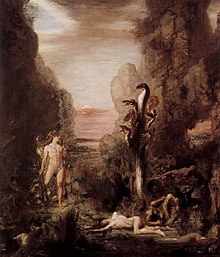Lernaean Hydra
|
Gustave Moreau's 19th-century depiction of the Hydra, influenced by the Beast from the Book of Revelation
|
|
| Grouping | Legendary creature |
|---|---|
| Sub grouping | Serpentine water spirit |
| Parents | Typhon and Echidna |
| Mythology | Greek mythology |
| Other name(s) | Lernaean Hydra |
| Country | Greece |
The Lernaean Hydra or Hydra of Lerna (Greek: Λερναῖα Ὕδρα, Lernaîa Hýdra), more often known simply as the Hydra, was a serpentine water monster in Greek and Roman mythology. Its lair was the lake of Lerna in the Argolid, which was also the site of the myth of the Danaids. Lerna was reputed to be an entrance to the Underworld and archaeology has established it as a sacred site older than Mycenaean Argos. In the canonical Hydra myth, the monster is killed by Heracles, using sword and fire, as the second of his Twelve Labors.
According to Hesiod, the Hydra was the offspring of Typhon and Echidna. It possessed many heads, the exact number of which varies according to the source. Later versions of the Hydra story add a regeneration feature to the monster: for every head chopped off, the Hydra would regrow one or multiple heads.
The Hydra had poisonous breath and blood so virulent that even its scent was deadly.
The oldest extant Hydra narrative appears in Hesiod's Theogony, while the oldest images of the monster are found on a pair of bronze fibulae dating to ca. 700 BCE. In both these sources, the main motifs of the Hydra myth are already present: a multi-headed serpent that is slain by Heracles and Iolaus. While the fibulae portray a six-headed Hydra, its number of heads was first fixed in writing by Alcaeus (ca. 600 BCE), who gave it nine heads. Simonides, writing a century later, increased the number to fifty, while Euripides, Virgil and others did not bother to give an exact figure. Heraclitus the paradoxographer rationalized the myth by suggesting that the Hydra would have been a single-headed snake accompanied by its offspring.
...
Wikipedia

